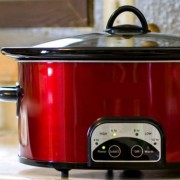Actually, meal planning is great for any kind of back-to-busy!
Adapted from veggie fairy Shanna D’s 5-part meal planning series:
After the summer, everything starts back up again, which can leave you grabbing whatever’s convenient to eat on the run. That can be hard on your body and your budget. Whether it’s back-to-school at your house or back-to-busy (or both), meal planning can keep you eating healthfully.
It took me a long time to figure out how to successfully meal plan for my family. I kept trying different meal planning systems – trying and failing.
I’m a busy, homeschooling mom. I’ve been a neighborhood market manager for Seasonal Roots’ home-delivered farmers market, and I used to be an agriculture research specialist… if anyone should’ve known how to meal plan, it’s me! Why wasn’t it working? What was I doing wrong?!
Step 1: Throw out the rules
The thing is, there are a lot of websites out there that will tell you how to plan a week of meals. I’d get frustrated trying to follow their rules and lose all the joy that came with cooking and eating nutritious food. What happened to meal planning making your life better, right?!
Well, better means different things for different people. For you, better may mean less time cooking, or less time shopping and more time cooking. Maybe you’re tired of wasting fresh veggies.
I was. I would find myself standing in the kitchen at 4:30pm wondering how I could turn a pile of wilty swiss chard and semi-mushy zucchini into dinner. It was often easier to compost it or even worse, throw it away and opt for the broccoli from the freezer. It was NOT working.
Meal planning IS the answer but everyone meal plans differently. I have diet restrictions and so does my daughter, but my husband can eat anything. Trying to make someone else’s meal plan fit our needs was a recipe for failure. Meal planning only started working when I figured out which rules fit our life. Then I threw the rest away.
So throw out the rules (not the fresh veggies)! With that in mind, check out these free meal planning resources. Just remember: Keep what works, throw the rest away.
http://realeverything.com/tag/meal-plan/
http://www.thekitchn.com/danielle-walker-new-york-times-best-selling-author-of-meals-made-simple-tells-us-how-she-meal-preps-for-the-week-229368
http://www.100daysofrealfood.com/our-free-meal-plans/
http://www.realsimple.com/food-recipes/recipe-collections-favorites/month-of-dinner-recipes
This next one has some sample plans, otherwise it’s a paid service:
http://emeals.com/meal-plans/?utm_source=bing&utm_medium=cpc&utm_term=meal%20plans&utm_campaign=B_Meal%20Plan
Step 2: Shop at home
My favorite way to start meal planning is to take inventory of everything I have on hand. In other words, I shop at home.
That was the problem back when I was using prefabricated meal plans. Many have shopping lists prepared for you based on meals selected. I would print these nice little lists and head to the store, completely disregarding what I already had at home or had ordered from Seasonal Roots. Not budget friendly! I was also buying weird products for recipes and never using them again.
Now, before I decide what to cook, I determine what I have, including what’s buried in my freezer. You never want to find the last pound of that beautiful, pastured breakfast sausage bundle you ordered from Seasonal Roots covered in freezer burn!
I was also freezing vegetables to help reduce waste, but… I didn’t know that they should be blanched prior to freezing. The veggies were almost always freezer-burned by time I remembered I had them. Argh.
Now let my order from Seasonal Roots and the freezer inspire my meal planning every week. I’m saving money and time!
Here’s a quick guide on how to freeze extra produce… the correct way, by blanching first!
Prepare a stock pot of boiling water.
Clean and roughly chop vegetables.
Prepare an ice bath for the blanched veggies.
Place chopped veggies into a wire basket and lower into rapidly boiling water for a few minutes. The time depends on the vegetable. Here’s a good guide for times.
After blanching, put the veggies straight into an ice bath. Once they’re cool, drain them and put them in a freezer-safe container or baggie.
You can find more info on freezing produce (which lets you save it for up to a year!), here on the Veggie Fairy Blog.
Step 3: Know your schedule
After I finish my home shopping and review my upcoming Seasonal Roots order, I have an accurate idea of what I have on hand. That’s what I use to inspire my weekly plan. But there’s one more vital piece to this puzzle: our weekly schedule.
It took me a while to figure that out. Normally families have the same commitments week in and week out, but when I assumed I could follow a plan that had a predictable daily themes, like Meatless Monday, Taco Tuesday, and so on, I failed again. It didn’t work.
Once a week batch cooking — a.k.a. cooking up a storm one day and using the pre-cooked items throughout the week — also didn’t work. No one in my family is ever stoked about leftovers and it felt like that was all we were eating.
I felt trapped. Once again, these “tried and true” meal plans were not working for me. I was either trying new recipes on my busiest days, or winding up with a large amount of cooked food that had to be eaten whether or not we felt like eating it just to avoid having to throw it away.
Then it finally hit me. Every week is unique. Duh! It seems so obvious now: If I was going to be successful, I had to plan meals that actually fit our schedule. Rules were tossed again. After all, tacos taste good any night of the week.
So now, Sunday is my planning day. I take about an hour and sit with a cup of coffee, cookbooks, Pinterest (where every week Seasonal Roots posts new recipes that use seasonal produce items), and my calendar planner.
Based on what’s actually on our schedule for the upcoming week, I can better decide which nights I should use the crock pot, which nights I can look forward to cooking, and which nights we will need to have leftovers. Leftover night is much more fun when you have a choice in the matter. So make your plan fit your schedule, not someone else’s.
Step 4: Teamwork
Teamwork makes the dream work! Five words that make my family giggle and remind us that we are in this together. But if teamwork is so important to our family, why was meal planning and cooking ALL on me?! Involving my family in the planning process was a game changer.
I was selecting all the meals when I was following prefabricated meal plans. It was easier this way, but I’d wind up frustrated when my family (mainly my daughter) wasn’t interested in eating what I had prepared.
We all have unique palates and I was only cooking to mine. Meals became more enjoyable for everyone once I started asking my husband and daughter for their input. This is yet another example of why following someone else’s meal plan is not always successful.
My family helps plan meals each week, which keeps us on track because we are all invested. This is important for children as well. Including kids in the planning process helps them learn healthy eating habits and will make them more excited about what’s on the table for meals. They’re more likely to try new things if they helped choose them.
My daughter helps me choose the items in our basket every Friday when the Seasonal Roots farmers market opens. Not only is she helping me plan, she’s learning where our food comes from. Many children are not aware of how our food production system works. Food doesn’t come from the grocery store — that’s simply a place where we can buy it. When we order from Seasonal Roots, we can choose our items and see which family farm it’s coming from.
Knowing where our food comes from and how to prepare it are important life skills. I’m helping my daughter learn by inviting her into the kitchen. In turn, she’s more willing to try new foods and eat what we prepare together. A total win-win!
And in conclusion…
Implementing these four things helped us transition from a family that eats on the fly to a family that plans. That’s helping us eat more healthfully. Hopefully it will help you too!
ABOUT SEASONAL ROOTS
Since 2011. , Seasonal Roots’ online farmers market has connected Virginia families with local family farmers who use sustainable, humane practices. Our veggie fairies – mostly moms who believe in living better through scrumptious, healthy eating, being kind to animals, protecting the environment, and spreading joy – home-deliver freshly harvested produce, eggs, grass-fed dairy and meat, plus artisan fare. We empower our members to eat better and live better with more nutritious, flavorful food that’s good for us and good for the planet. More info at seasonalroots.com.







